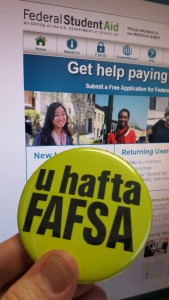By Jim DiUlio, Director of Wisconsin’s 529 college savings program
January 25, 2016
January 25, 2016
The FAFSA season just opened, and if you’re currently in college you know this annual activity. However, for first-time college students in 2016, here are some tips to get started. There are two family-friendly changes to FAFSA this year, and there are places to find free money for college…so read on!
The federal government coordinates FAFSA, or the Free Application for Federal Student Aid, as the starting point to find federal or state financial aid for higher education, along with college-specific benefits. The process takes a snapshot of a family’s finances, which is then compared to a particular institution’s cost. Then a package of grants, loans, or employment is prepared by a college to help meet the need. A new calculation is required each year, since situations change. Some colleges request an additional form, called the CSS, to gather more data. Completing the FAFSA early in the year is important; many grants and scholarships are offered on a first-come, first-served basis.
The financial data you need is listed at fafsa.ed.gov. The old paper FAFSA form was a multi-page monster, but now the on-line version is intuitive, with help buttons, and it allows data to be added later. A convenient app imports federal tax return numbers from the IRS online, rather than requiring one to scan and submit the entire return.
To help with your early start, a new rule this year lets you enter 2014 income tax numbers instead of waiting to complete your 2015 tax return. Updates may be added later. Deadlines vary from state to state and at certain schools. See a listing of state deadlines is at fafsa.ed.gov.
Free help to get started with FAFSA is available in February and March, with experts leading two-hour workshops at many locations nationwide. What started out as an afternoon event called College Goal Sunday has expanded to multiple Saturdays, Sundays, and weeknights in nearly every state. Volunteers at these events include college financial aid officers, high school counselors, and 529 plan staff.
It baffles me why a many high school seniors choose to send their FAFSA report calculations to only one college or university. Families routinely compare and shop for lawn mowers, but somehow forget that when shopping for something costing many, many times more. You should choose at least a few school alternatives in your geographic or academic area of interest to see what’s available. FAFSA allows the results to be sent to ten or more schools.
Also new for 2016 is a FAFSA privacy feature. The multiple schools you select are no longer told of your other choices, and should make their offers more competitive and allow you to do a bit of negotiating if needed.
An earlier experience with an older child applying for aid may have left you confused. I recommend your best resource to help decipher the process are the financial aid officers at any college, technical college, or university. They monitor the constantly changing status of dozens of state and federal programs, funding availability, and the process and deadlines that are specific to many of them. Sort of like handling a hundred story problems at the same time. Each student presents a unique situation, and they are experts at matching limited resources with individual dreams.
And now about the free money for college. Financial aid offices often receive bequests from individuals, foundations, or companies as part of planned giving or a legal charter. I worked with a retired science teacher who wanted to help first-year engineering students at a particular campus. Whether you are a bassoon major, a gymnast, a student of romance languages, or a budding astronomer, there could be money waiting for you out there. A quick internet search finds many leads for these free scholarships and grants. Some families challenge their high school junior or senior, matching any scholarship money the student can generate among the hundreds of sources. Every little bit helps!
In sum, don’t delay. The sooner you get the FAFSA completed, the sooner you get on to all those other pre-college plans, like finding a cool place to live and where to get good late-night pizza or wings.
About the Author:
Jim DiUlio is the director of Wisconsin’s 529 college savings program, holding $4 billion in two plans: direct-sold Edvest, and Tomorrow’s Scholar, available through financial advisors and fee-only planners. Jim also serves as Vice Chair of the College Savings Plans Network.
Jim DiUlio is the director of Wisconsin’s 529 college savings program, holding $4 billion in two plans: direct-sold Edvest, and Tomorrow’s Scholar, available through financial advisors and fee-only planners. Jim also serves as Vice Chair of the College Savings Plans Network.


